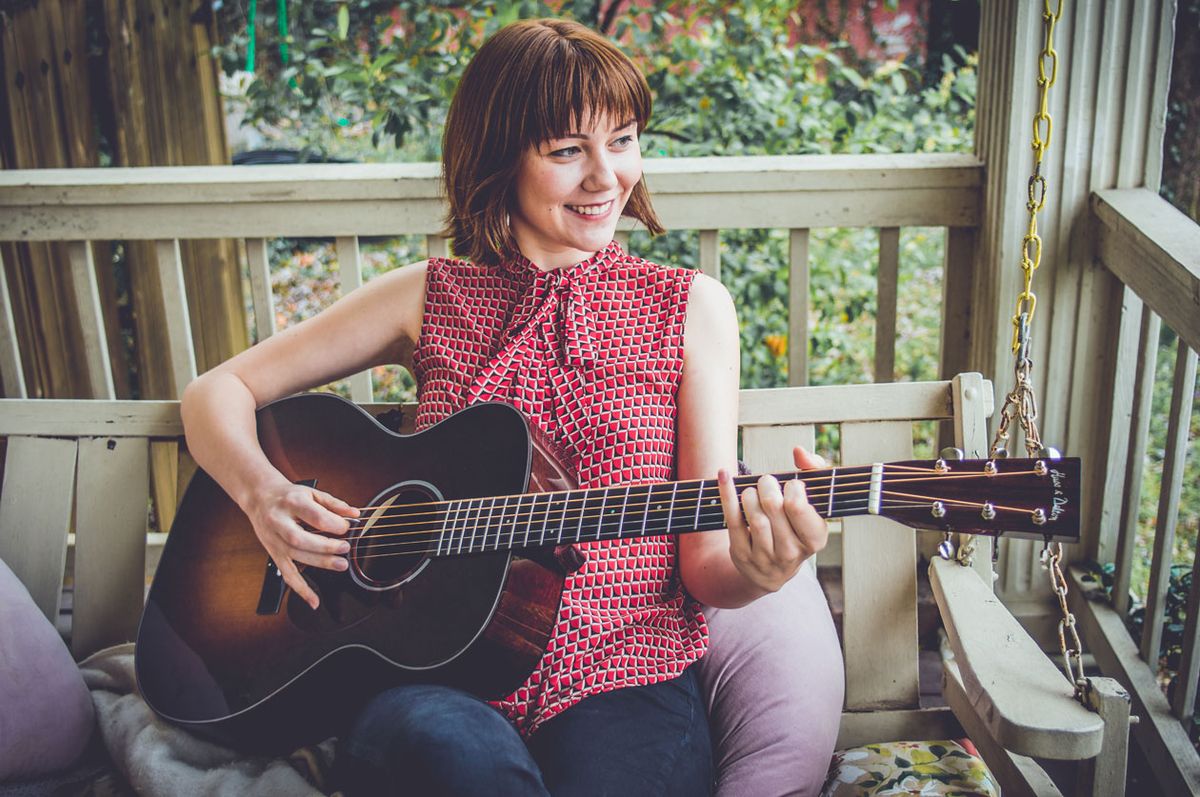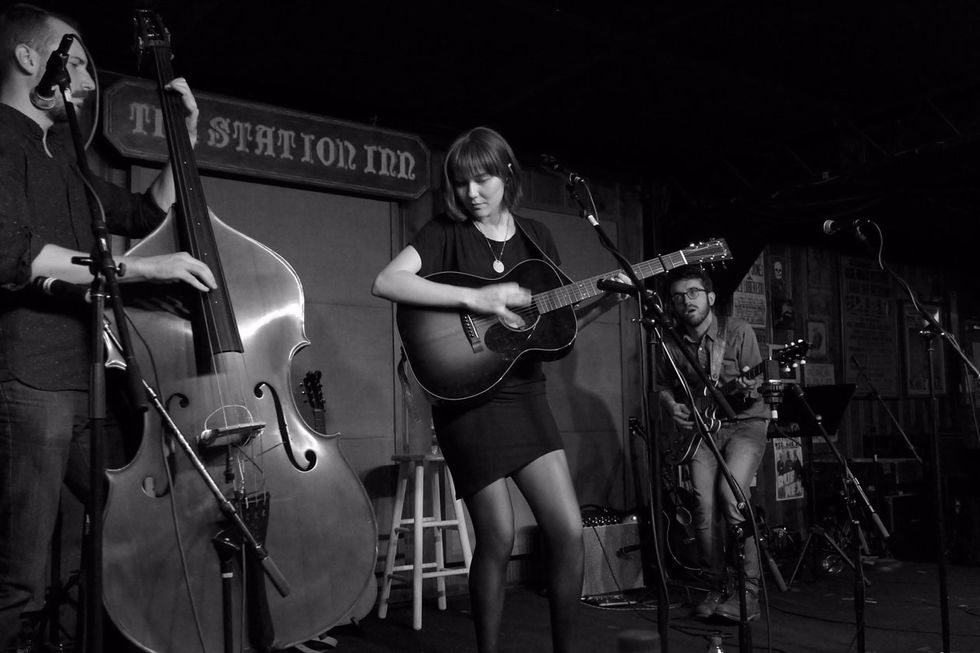From her family band to Nashville’s epicenter, the guitarist has blazed a trail with sizzling clawhammer and crosspicking technique, and high ’n’ lonesome singing.
There is renewed interest in roots music among young musicians, with artists like the Punch Brothers, the Milk Carton Kids, and Sarah Jarosz drawing liberally from bluegrass, country, and folk influences. Among the most brilliant guitarists in this new generation is Molly Tuttle, who seems as effortlessly conversant when flatpicking as when playing in the clawhammer style, and who is equally gifted as a singer-songwriter.
At 24, Tuttle has already found her own voice on the guitar, and this was perhaps inevitable. Tuttle picked up the guitar at age 8, wanting to emulate her multi-instrumentalist father, Jack Tuttle, a fixture then and now on the Northern California acoustic music scene. She devoured bluegrass and Western swing standards with her brothers, Sullivan and Michael Tuttle, and the siblings, under the direction of the elder Tuttle, performed and recorded as the Tuttles.
Tuttle was only 13 when she released her first album, The Old Apple Tree, a collection of duets with her father on which she plays guitar and banjo, as well as sings. And she was not much older that that when she and her dad won a contest to perform on NPR’s A Prairie Home Companion.
After solidifying her command of the guitar—and of music in general—at Boston’s Berklee College of Music, Tuttle began racking up some prestigious accolades: first place in the annual songwriting competition at MerleFest and an up-and-coming instrumentalist award from the International Bluegrass Music Association (IBMA). This year, she’s nominated for three more IBMA awards: emerging artist, female vocalist, and guitar player of the year.
Tuttle is now based in Nashville and performs in a variety of situations: with the Goodbye Girls, an old-timey band that came together at Berklee; as the leader of her own band; and solo. She’s just released Rise, an EP that offers her fresh take on the bluegrass tradition and is also her first recording of all-original songs as a bandleader.
You grew up in the bluegrass community in the San Francisco Bay Area. What was that like?
It was awesome. My dad was a music teacher. Growing up he would take me to camps and festivals. I just got to know the bluegrass scene really well in the Bay Area. Everyone was so supportive. I think that’s kind of common in bluegrass music all over the country, with the older generations bringing up the younger generations and having them onstage—just being really supportive and always looking after them. It was a great community and scene to grow up in.
Your father, Jack Tuttle, still teaches at Gryphon Stringed Instruments, which is kind of a mecca for acoustic guitarists, in Palo Alto. It must have been fun to visit the shop as a child.
Yeah. I loved going in there and looking at guitars. When I was first starting, I really wanted a Martin guitar. I saved up for one for a long time, and when I was 12 I finally went to Gryphon and got one.
That’s great. Which kind of Martin?
I got an HD-28. It’s like a standard D-28, basically, but with herringbone trim.
What was it like being in a family band when you were a teenager?
It was fun. We would play out on weekends sometimes. Probably in our busiest year, we did three or four festivals over the summer. So, we didn’t play a lot, but it was always a great experience. And that’s kind of how I learned to work in a band and come up with arrangements with other people and craft a show together, instead of just jamming with friends.
How did your family’s dynamic play into the band?
When I first started, it was kind of my dad leading the band and coming up with the arrangements. As I got older and started developing my own musical tastes and musical voice, I would help with that more. I would have different ideas and opinions about what we should do. The dynamic definitely changed as I got older and I took more initiative.
We made an album when I was about 16 [Introducing the Tuttles With A.J. Lee]. I helped arrange it and mix everything. It was a good learning experience to be introduced to some basic software and to the recording process in general, which my dad previously did all on his own.

TIDBIT: Produced by Kai Welch in Nashville, Tuttle’s seven-song debut as a leader showcases her guitar chops and voice in a way that expands the framework of her repertoire and the bluegrass tradition.
I understand you played banjo in the family band.
Yeah, I did. I would switch between guitar and banjo, because one of my brothers [Sullivan Tuttle] plays guitar. I always favored the guitar myself, but it was nice to play the banjo as well. Now that I don’t really play as much with my family, my banjo has gotten neglected and I kind of miss it.
How do you think playing the banjo has impacted your guitar playing?
It’s hard to say. I kind of understand the banjo and how it works overall, so I think that definitely plays into my crosspicking on the guitar. I use a lot of crosspicking, or just adding in extra picked notes [on adjacent strings] to play things that many guitar players would do a little more linearly. It just adds a different feel and texture.
You studied at Berklee and presumably learned a lot from outside of bluegrass while there. How do you think that changed your approach to the guitar and to music in general?
It definitely drastically changed it. I think just being exposed to different genres, and also learning theory and listening to more jazz than I ever had, really transformed how I thought about improvising and playing guitar. I didn’t know any music theory before going there—not even the notes on the guitar. Learning that, and how a scale is built, not to mention all the different modes … that kind of just blew open a whole new way of talking about music with people and also just understanding what I was playing.
Onstage with her band at Nashville’s Station Inn, Tuttle performs with bassist Royal Massat and guitarist Anthony da Costa. Tuttle typically favors her Huss & Dalton custom-built dreadnought with bands, “because it definitely has the right sound and the right power for that context.” Photo by Manendra Pedris
Do you think there were benefits to not having learned theory until later? Are your ears stronger because of it?
I think they’re definitely stronger because I didn’t read any music and basically learned everything by ear. I don’t regret not having learned it earlier, but I do think theory goes hand-in-hand with ear training. The two can really help each other. Again, once I got to Berklee, it all clicked into place and made sense.
Did you experience any kind of cultural shock when you landed in Boston to attend Berklee?
Moving from Palo Alto, where I grew up, to Boston wasn’t too bad. Though Boston’s a bigger city and Palo Alto’s more of a suburb, it felt pretty similar—similar demographically and culturally, anyway, as they’re both pretty diverse places. Moving to Nashville was more of a culture shock than either of those two places.
How so?
I think the culture in the South is just different—more so than between the East Coast and the West Coast. It took me a while to get used to it, but I really like it here.
What’s it like to work in a town that’s so important to music—especially to bluegrass and country?
It’s amazing. I forget about it sometimes, and all of a sudden I realize how many amazing musicians I’m interacting with all the time and running into. It starts to feel normal, and then you realize you’re just meeting all these great people all the time, collaborating with them and doing very cool and hopefully historical things. Also, it’s really cool to check out the venues around town, where there are always amazing musicians playing.
You’ve found your own voice using bluegrass as a foundation. Has that been a conscious thing or just something that happened organically?
I’ve definitely thought about it. I’ve tried to sound like myself and not copy any one artist too closely. It’s obviously impossible not to be influenced by other musicians, but I’ve consciously tried to take my own path. When I stumble on something that sounds original, instead of tossing it out, I always think, “What can I do with that?” My style comes from not being afraid to take some risks.
Molly Tuttle’s Gear
Guitars• Huss & Dalton custom TD-R dreadnought
• Huss & Dalton custom OM
Strings, Picks, and Capos
• D’Addario EXP17 Coated Phosphor Bronze Medium (.013–.056)
• Dunlop JD JazzTone 208
• Shubb FineTune
Are there any examples on Rise that started off with you happening upon an idea that struck you as original?
Yeah. I think “Save This Heart” is a good example, where I was using a clawhammer guitar technique. Not many people play that style of guitar, and I feel like within it, I’ve stumbled on some different rhythmic things that are kind of original for both clawhammer guitar and acoustic guitar in general. When I wrote that song, I felt confident that it sounded pretty original and didn’t fit neatly in any genre.
That definitely comes across. You seem equally adept at flatpicking and fingerpicking, but do you feel more confident using one approach versus the other?
Definitely flatpicking. I can do some fingerpicking, but I have to work it out ahead of time and practice it for a while before I want to play it for anyone. Flatpicking just feels like home base for me.
It’s cool how the guitar interacts with the pedal steel and banjo and fiddle and other instruments on the album. How much pre-planning went into the arrangements?
There was quite a bit of spontaneity. The album was partially planned out, and things were pretty spontaneous when the guests came in to record. Some of the players, like Darrell Scott [on electric and lap-steel guitars], hadn’t even heard the songs before we recorded them, and he just came in and improvised. And for the solos and stuff, everyone was just improvising and trying to play off each other.
Speaking of solos, what do you think about when you improvise? Are you thinking about the structure or just playing freely? Do you have any strategies in mind?
When I play a solo, I like to think about creating a motif and coming back to it. Maybe I’ll hear something that someone else just played and try to create a motif out of that, which I’ll then develop throughout the solo. I also always try to have the melody in my mind. And I think about the overall form of the solos. If I want to reach a peak at the end of the solo, then I’ll start out a little less note-y and gradually build things up. It’s all about both being in the moment and seeing the bigger picture.
Is that something you do naturally or something you learned through studying jazz at Berklee?
I think I soaked it in from listening to lots of different music. I studied jazz theory, but I didn’t ever really get proficient at playing jazz. But listening to really great soloists was definitely helpful.
Are there any soloists that stick out for you?
For acoustic guitar, my favorite guitar player might be Dave Rawlings, because he’s always just so tasteful and he really is great at building a solo. He’s always been my acoustic guitar hero. As for other guitar players, there’s a great guy I just saw last night in Nashville, Jack Pearson, who’s played with the Allman Brothers [in the late 1990s]. He’s an amazing electric player and is really inspiring to see live. David Grier is another one of my favorites as well.
Getting back to the album, on the instrumental “Super Moon,” it sounds like your 6th string is tuned down to D. Do you use alternate tunings or mostly standard?
I started to explore nonstandard tunings recently. I’ve really been liking DADGAD, and “Save This Heart,” on the album, is in an alternate Gsus tuning [low to high: D–G–D–G–C–D]. Everything else is in standard except “Super Moon,” which, like you noticed, is in dropped D. I didn’t used to be into alternate tunings, but I’ve gone through Europe on tour a couple times, and I’ve met a lot of guitarists over there who play in different tunings, so that’s inspired me to get into it more.
Are there any players in particular who’ve inspired you to explore?
I really like Scandinavian music, and this guitar player, Roger Tallroth, who’s in the band Väsen, has his own tuning. I can’t think of how it’s spelled off of the top of my head. [Editor’s note: It’s low to high: A–D–A–D–A–D.]] I love his guitar playing, and it’s kind of inspired me to step outside of my comfort zone.
On a different note, tell me about your guitars.
I have two Huss & Daltons: One is an OM and the other’s a dreadnought. The dreadnought is a TD-R. It’s a rosewood guitar with a thermo-cured [Adirondack spruce] top. The OM also has a thermo-cured top and is a mahogany guitar, with a sunburst finish.
How do you decide when to use the mahogany OM versus the rosewood dreadnought?
I use the dreadnought when I’m playing with a full bluegrass band, because it definitely has the right sound and the right power for that context. The OM has been my go-to lately for playing solo or in a duo or trio. It’s brand new. I just got it a couple months ago and I’m really excited about it.
What has it been like to blend your acoustic guitars with electrics like you’ve been doing recently?
It was exciting for me to hear it in that way. Before recording Rise, I hadn’t really played much with electric guitar players, except with some of my teachers at Berklee. Mostly I just worked with acoustic musicians. It was really exciting and it was something I’d wanted to do for a long time: to experiment with different sounds, and play with percussion and electric guitar. It helped me hear songs in a new way. It was a good step to push me forward into finding a unique sound.
YouTube It
Molly Tuttle displays her guitar and vocal prowess on a ripping version of Townes Van Zandt’s “White Freightliner Blues” at the office of Dave Stewart Entertainment in 2014—figuratively and literally hitting all the right notes!


